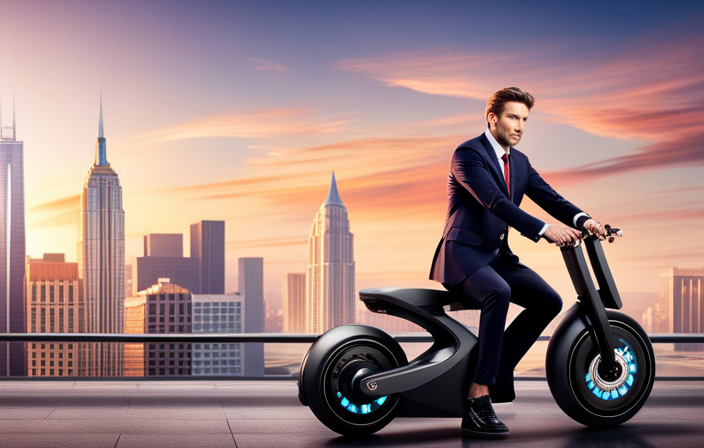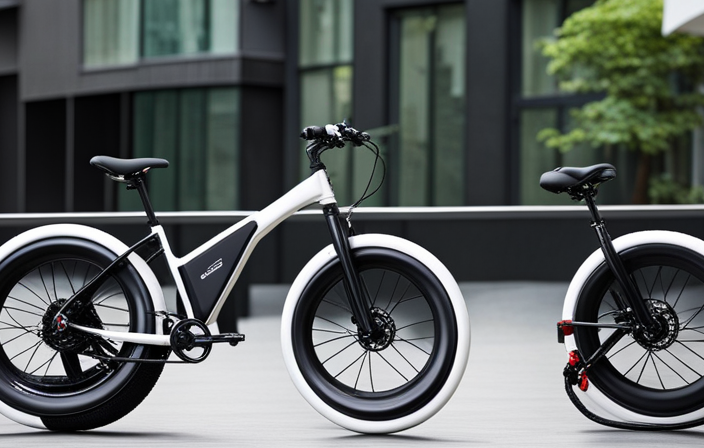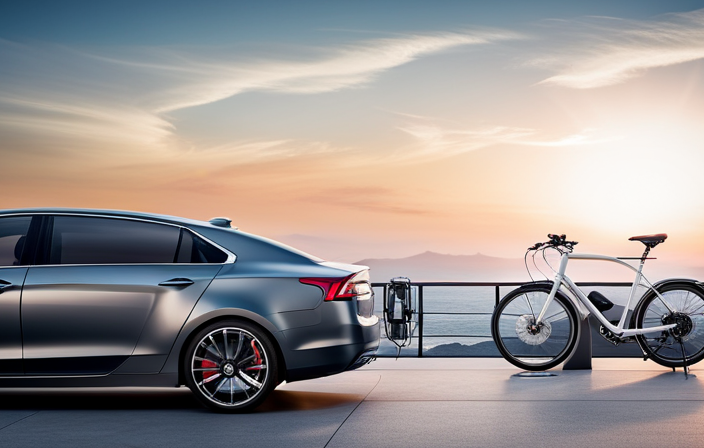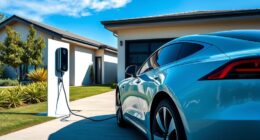Pondering the precise period it takes to power up your electric bike? Prepare to plunge into the particulars of the charging process.
How long it takes to charge an electric bike relies on various factors, from battery capacity and charging method to power output and environmental conditions. Delve into this electrifying exploration to uncover estimations for charging time according to battery capacities, as well as tips for accelerating the process.
Embark on this educational excursion and embrace the future of e-bike charging technology.
Key Takeaways
- Optimal charging techniques for electric bikes include avoiding overcharging or undercharging the battery, charging at a moderate temperature, using a dedicated charger designed for the battery capacity, and following the recommended charging voltage and current.
- Factors that influence the charging time for electric bikes with large battery capacity include charging voltage within the recommended range, charging current below the maximum limit, moderate battery temperature, charging from a higher state of charge, and using a dedicated charger for large battery capacities.
- Tips for faster charging include using a high-quality charger designed for your bike’s battery, investing in a charger with higher wattage output, charging at a higher voltage if your charger allows, and optimizing charging by not fully draining the battery.
- Proper charging etiquette and safety precautions include using the correct charger for your electric bike model, charging in a well-ventilated area away from flammable materials, avoiding the use of fast chargers unless recommended by the manufacturer, ensuring reliable and compatible charging infrastructure, and following guidelines to maintain safe and efficient charging.
Battery Capacity and Type
You’ll need to consider the battery capacity and type of your electric bike when determining how long it will take to charge. The battery life and charging efficiency play a crucial role in this process.
Battery capacity refers to the amount of energy the battery can store, usually measured in watt-hours (Wh). Higher capacity batteries will take longer to charge compared to lower capacity ones. Additionally, the type of battery used in your electric bike will also affect the charging time. Lithium-ion batteries, for example, are commonly used due to their high energy density and long lifespan. They typically charge faster than other battery types.
When considering the charging method and equipment, keep in mind that different chargers and charging stations may have varying charging speeds. Transitioning into the subsequent section, the charging method and equipment you choose will further impact the overall charging time.
Charging Method and Equipment
Using the appropriate equipment, it’s possible to efficiently recharge an e-bike. The charging method and equipment you choose can greatly affect the charging speed of your electric bike. Portable chargers are a popular option for recharging e-bike batteries on the go. These compact devices allow you to charge your battery anywhere, making them a convenient choice for riders who need to top up their battery during a long ride or while traveling. However, it’s important to note that portable chargers may have a lower power output compared to traditional chargers, which can result in longer charging times. In the next section, we will explore the impact of power output on the charging process.
Power Output
The power output of the charger greatly affects the speed at which the battery recharges. When charging an electric bike, it is important to consider the power efficiency of the charger. A higher power output means faster charging, as more energy is being transferred to the battery per unit of time. To understand the impact of power output on charging speed, consider the following:
-
Higher power output chargers, such as those with 5 or 6 amps, can recharge the battery in a shorter amount of time compared to lower power output chargers.
-
Charging at a higher power output may result in a slightly reduced battery lifespan due to increased heat generation.
-
It is recommended to use a charger with a power output that is compatible with your electric bike’s battery specifications to ensure optimal charging speed and efficiency.
Considering the power output of the charger is just one aspect of charging an electric bike. The next section will delve into the state of charge and its significance in the charging process.
State of Charge
Don’t forget to consider the state of charge when recharging your battery. The state of charge refers to the current level of energy stored in the battery. It is important to understand this because it can affect the battery life and charging speed of your electric bike.
To illustrate this, let’s take a look at the following table:
| State of Charge | Battery Life | Charging Speed |
|---|---|---|
| Low | Shortened | Slower |
| Medium | Moderate | Normal |
| High | Extended | Faster |
As you can see, the state of charge plays a significant role in determining both battery life and charging speed. It is crucial to recharge your battery when it reaches a low state of charge to avoid shortening its lifespan. This will also ensure that you can charge your electric bike at a normal or faster speed. Now, let’s move on to the next section, where we will discuss the impact of environmental factors on charging time.
Environmental Factors
One factor that can affect the speed of recharging is the environment. The charging efficiency of an electric bike can be influenced by various environmental factors.
For instance, extreme temperatures, both hot and cold, can impact the charging process. High temperatures can reduce the efficiency of the charging system, resulting in a slower charging time. On the other hand, extremely cold temperatures can also affect charging efficiency and may require more time to fully charge the battery.
It is important to note that charging in optimal temperature conditions will not only improve the speed of recharging but also have a positive impact on battery life.
Speaking of battery life, the next section will delve into the topic of battery health and age, which plays a crucial role in determining the charging time.
Battery Health and Age
Battery health and age significantly impact the speed at which an electric bike can be recharged. Proper battery performance and maintenance are crucial for maintaining optimal charging speed. As a battery ages, its capacity to store and deliver power gradually decreases. This reduction in capacity directly affects the charging time required. Additionally, factors such as temperature, usage patterns, and charging habits can also impact battery health and performance. To illustrate this, consider the table below:
| Battery Age | Charging Time |
|---|---|
| New (0-1 year) | Shorter charging time |
| Moderately aged (1-3 years) | Slightly longer charging time |
| Old (3+ years) | Longer charging time |
Understanding battery performance and implementing proper battery maintenance practices can help maximize charging efficiency. Now, let’s delve into the next section to explore charging time estimates for different battery capacities.
Charging Time Estimates for Different Battery Capacities
When it comes to charging time estimates for different battery capacities, there are a few key points to consider.
For small battery capacities, such as 36V/10Ah, you can expect a charging time of around 4-6 hours.
Medium battery capacities, like 48V/14Ah, will typically require a charging time of 6-8 hours.
And for larger battery capacities, such as 72V/20Ah, you can anticipate a longer charging time of around 8-10 hours.
Small Battery Capacity (e.g., 36V/10Ah)
To fully charge your electric bike with a small battery capacity, it won’t take you too long. With a charging efficiency of around 90%, you can expect a 36V/10Ah battery to charge in approximately 2-4 hours. However, keep in mind that the charging time may vary depending on the specific charger and battery condition.
To ensure optimal performance and longevity of your battery, it is essential to follow proper battery maintenance practices. Here are a few tips to keep in mind:
- Always use the charger provided by the manufacturer to maintain the charging efficiency.
- Avoid overcharging the battery, as it can negatively impact its lifespan.
- Charge your electric bike in a cool and well-ventilated area to prevent overheating.
- Regularly inspect and clean the battery terminals to ensure a good connection.
Now, let’s move on to the next section about medium battery capacity (e.g., 48v/14ah).
Medium Battery Capacity (e.g., 48V/14Ah)
With a medium battery capacity of 48V/14Ah, you can expect a charging time of approximately 3-5 hours.
Charging efficiency plays a crucial role in determining the time it takes to charge an electric bike. To ensure optimal charging, it is recommended to use the charger specifically designed for your bike’s battery and to follow the manufacturer’s guidelines.
Additionally, it is important to consider the charging techniques that can enhance efficiency. For example, charging at room temperature and avoiding extreme temperatures can help maintain the battery’s health and improve charging efficiency. It is also advisable to avoid overcharging or undercharging the battery, as these practices can negatively impact its performance and lifespan.
By following these optimal charging techniques, you can ensure that your medium battery capacity electric bike charges efficiently and effectively.
Moving on to the next section about large battery capacity (e.g., 72V/20Ah), you’ll find even more insights on charging times and techniques.
Large Battery Capacity (e.g., 72V/20Ah)
The charging time for a large battery capacity, such as 72V/20Ah, can vary depending on the charging techniques and conditions. It is important to consider the charging time when charging a battery with higher capacity to ensure optimal battery life.
Here are some factors that can influence the charging time for a large battery capacity:
-
Charging voltage: A higher charging voltage can reduce the charging time, but it should not exceed the battery’s recommended voltage range.
-
Charging current: A higher charging current can also decrease the charging time, but it should not surpass the battery’s maximum charging current.
-
Battery temperature: Charging at moderate temperatures can help maintain a faster charging rate.
-
Battery state of charge: Charging from a lower state of charge may require more time compared to charging from a higher state of charge.
-
Charging method: Using a dedicated charger designed for large battery capacities can ensure efficient and faster charging.
Considering these factors, you can optimize the charging time for a large battery capacity while maintaining its overall battery life.
By following these guidelines, you can now explore some tips for faster charging.
Tips for Faster Charging
Charging an electric bike faster can be achieved by following these tips.
To start, make sure you are using a high-quality charger specifically designed for your bike’s battery. Additionally, consider investing in a charger with a higher wattage output, as this will speed up the charging process.
Another technique for faster charging is to charge your battery at a higher voltage, if your charger allows for it. This can reduce the overall charging time significantly.
Furthermore, it’s important to optimize the charging process by charging your battery when it is not completely drained. Partial charging can be more efficient and save you time.
Finally, always follow charging etiquette and safety guidelines to ensure the longevity of your battery.
Transitioning into the next section, understanding proper charging etiquette and safety precautions is crucial for maintaining the health and performance of your electric bike’s battery.
Charging Etiquette and Safety
Make sure to follow proper charging etiquette and safety precautions to ensure the health and performance of your battery. When it comes to charging your electric bike, there are a few key considerations to keep in mind. Firstly, always use the charger that is specifically designed for your electric bike model. Using an incorrect charger can damage the battery and reduce its lifespan. Additionally, it is important to charge your electric bike in a well-ventilated area, away from flammable materials, to prevent any potential accidents. Furthermore, be mindful of the charging speed and avoid using fast chargers unless recommended by the manufacturer. Using fast chargers can generate excessive heat and negatively impact the battery’s longevity. Lastly, it is crucial to ensure that the charging infrastructure you use is reliable and compatible with your electric bike. By adhering to these guidelines, you can maintain a safe and efficient charging process. Looking towards the future, advancements in charging technology will continue to improve the charging speed and infrastructure, making it even more convenient for electric bike users.
Future Developments and Improvements in Charging Technology
Get ready for exciting advancements in the future of charging technology for your e-bike. As the popularity of electric bikes continues to rise, manufacturers are constantly striving to improve efficiency and convenience.
One of the most promising developments is wireless charging. Imagine being able to simply park your bike near a charging pad and have it automatically replenish its battery without the need for any cables or connectors. This technology utilizes electromagnetic fields to transfer energy from the charging pad to the bike’s battery, making the charging process seamless and hassle-free.
Not only does wireless charging eliminate the inconvenience of plugging in your bike, but it also reduces wear and tear on connectors, extending the lifespan of your e-bike.
With these advancements, the future of charging technology for e-bikes is looking brighter than ever.
Frequently Asked Questions
Can I overcharge my electric bike battery?
Yes, you can overcharge your electric bike battery, which can pose risks to the battery’s lifespan. It is important to avoid leaving it connected to the charger for an extended period of time to prevent overcharging.
Is it safe to charge my electric bike battery overnight?
Don’t fret! Charging your electric bike battery overnight won’t harm its lifespan. However, it may slightly decrease efficiency compared to shorter daytime charges. To optimize battery health, consider regular shorter charging periods.
How often should I charge my electric bike battery?
Charge your electric bike battery regularly to maximize battery lifespan. Develop good charging habits by avoiding frequent deep discharges and charging the battery before it reaches a low level.
Can I use a different charger to charge my electric bike battery?
Using a different charger to charge your electric bike battery can be risky. Non-compatible chargers may not provide the correct voltage or current, leading to damage or even fire hazards. Always use the charger provided by the manufacturer for optimal compatibility and safety.
Can I charge my electric bike battery in extreme temperatures?
When charging your electric bike battery in extreme temperatures, it is important to follow best practices. Ensure the battery is not exposed to temperatures below freezing or above its recommended operating range to maintain optimal performance and prolong its lifespan.
Conclusion
Congratulations! You’re now equipped with the knowledge to determine how long it will take to charge your electric bike.
By understanding factors such as battery capacity, charging method, power output, state of charge, and environmental factors, you can estimate the charging time required.
Remember to follow charging etiquette and safety guidelines to ensure a smooth and safe charging experience.
As advancements in charging technology continue, the future holds promising improvements for faster and more efficient charging, like a lightning bolt charging up your electric bike.
So, charge up and hit the road with electrifying speed!
















